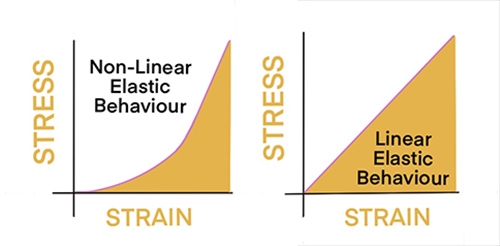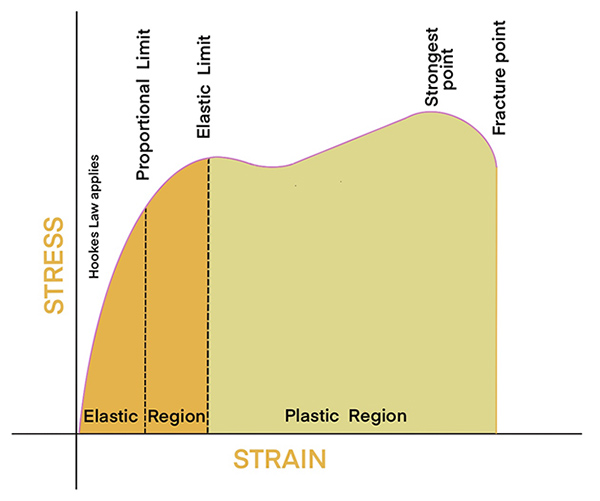Elasticity in construction
Elasticity describes the degree to which a material returns to its original shape after an external force or load has caused it to deform. All materials to some degree show elastic characteristics, some more so than others. This behaviour is a crucial characteristic of building materials without which they would suffer continuous deformation under load and ultimately collapse.
Linear elasticity occurs when the deformation in a material is proportional to the load applied, on a graph of stress and strain the line is straight. So, if a person weighing 50kg causes a diving board to deflect by 300mm, and another person weighing 100kg causes an identical board to deflect by 600mm, the diving board is exhibiting linear deflection. Most structural materials are, within limits, linearly elastic and are used within their linearly elastic range. Hooke's law of elasticity (named after the English scientist Robert Hooke in 1660) states that, for relatively small deformations of an object, the displacement or size of the deformation is directly proportional to the deforming force or load ie it is linear.
The point where the elasticity of a material is increasingly less linear and becomes non-linear is call the proportional limit. Non-linear elasticity occurs when the deformation in a material is not always proportional to the load applied, the behaviour changes as the load varies. On a graph of stress and strain the line representing the behaviour of the material curves.
The degree of elasticity will usually depend on the individual structure of a material at a microscopic level. In polymers and rubbers elasticity is created by stretching polymer chains under an applied force, whilst in metals elasticity results from a resizing and reshaping of crystalline cells of the materials structure (lattice).
Elastic materials have a limit which is the maximum stress per unit area it can withstand before being permanently deformed, this is called the elastic limit. After this point the material behaviour is plastic (ie it doesn't return to its original form and is permanently deformed).
[edit] Related articles on Designing Buildings
- Concept structural design.
- Detailed design.
- Elastic limit.
- Elements of structure in buildings.
- Moment.
- Plasticity.
- Stiffness.
- Structural engineer.
- Structural principles.
- Structural systems for offices.
- Structural vibration.
- Structures at the end of their design life.
- The development of structural membranes.
- Types of structural load.
- Vibrations.
Featured articles and news
RTPI leader to become new CIOB Chief Executive Officer
Dr Victoria Hills MRTPI, FICE to take over after Caroline Gumble’s departure.
Social and affordable housing, a long term plan for delivery
The “Delivering a Decade of Renewal for Social and Affordable Housing” strategy sets out future path.
A change to adoptive architecture
Effects of global weather warming on architectural detailing, material choice and human interaction.
The proposed publicly owned and backed subsidiary of Homes England, to facilitate new homes.
How big is the problem and what can we do to mitigate the effects?
Overheating guidance and tools for building designers
A number of cool guides to help with the heat.
The UK's Modern Industrial Strategy: A 10 year plan
Previous consultation criticism, current key elements and general support with some persisting reservations.
Building Safety Regulator reforms
New roles, new staff and a new fast track service pave the way for a single construction regulator.
Architectural Technologist CPDs and Communications
CIAT CPD… and how you can do it!
Cooling centres and cool spaces
Managing extreme heat in cities by directing the public to places for heat stress relief and water sources.
Winter gardens: A brief history and warm variations
Extending the season with glass in different forms and terms.
Restoring Great Yarmouth's Winter Gardens
Transforming one of the least sustainable constructions imaginable.
Construction Skills Mission Board launch sector drive
Newly formed government and industry collaboration set strategy for recruiting an additional 100,000 construction workers a year.
New Architects Code comes into effect in September 2025
ARB Architects Code of Conduct and Practice available with ongoing consultation regarding guidance.
Welsh Skills Body (Medr) launches ambitious plan
The new skills body brings together funding and regulation of tertiary education and research for the devolved nation.
Paul Gandy FCIOB announced as next CIOB President
Former Tilbury Douglas CEO takes helm.
UK Infrastructure: A 10 Year Strategy. In brief with reactions
With the National Infrastructure and Service Transformation Authority (NISTA).

























Comments
[edit] To make a comment about this article, or to suggest changes, click 'Add a comment' above. Separate your comments from any existing comments by inserting a horizontal line.